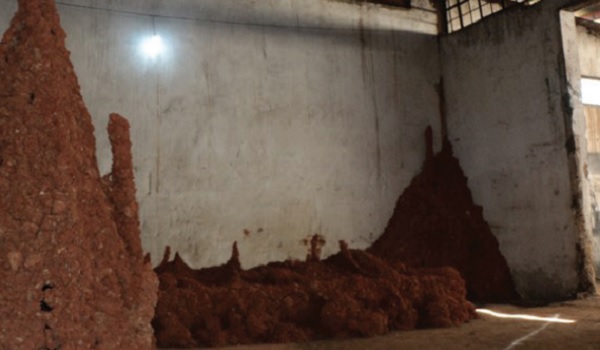
Impermanent takes on permanent social-political issues
Kampala, Uganda | DOMINIC MUWANGUZI | Most Ugandans are familiar with anthills; mounds of soil built by termites or ants, usually outdoors, in open grounds, away from modernity. But what if you find the anthill inside a house or along a busy city street? Now, that would be shocking and uncomfortable.
And that was the inspiration for a gigantic art installation titled `Invaders’ by Gilbert Musinguzi at the KAB018 exhibition.
Musinguzi’s art is part of a new movement to appreciate art that is not painting or sculptures; solid and long-lasting. Instead, it is art that is temporary and impermanent, or as it is largely known in art circles – ephemeral.
Ephemeral art is art that is created to last for a short amount of time. It could be a video installation, performance art, or site specific installation.
It emerged on the global art scene in the 1960s; pioneered by the Fluxus movement that spanned the globe from New York, USA, with a view that anyone can produce art. It featured top names like renowned sculptor, and art theorist Joseph Beuys from Germany and others who were dissatisfied by the long tradition of heroic and object- oriented paintings and sculptures.
On the Kampala art scene, it is a new trend popularised by artists like Bruno Ruganzu, Sandra Sssubi and Reagan Kandole and featured in two recent art festivals: The Kampala Art Biennale2018 and KLA ART 018.
Hellen Nabukenya had a voluminous installation `Munno Mu Kabi’ perched on a storied building in Kiyembe Lane, a busy part of the central business district of Kampala city, as part of the theme of KLA ART 018 dubbed `OFF THE RECORD’.
Ephemeral art uses appropriated objects or materials like earth, textiles, wood, organic media like human figures, and animals. The artist has no motive to create the artwork to be stored in a museum or the traditional art gallery. Therefore, most of the art is constructed in open space to enable easy access to it. To ensure the audience relates to it, the artists usually tackle the prevailing political-social issues.
They use objects that the audience is familiar with; often adopting found objects. In light of such familiarity, this art is more eloquent in providing a social and political commentary on the prevailing situation in any community.
Musinguzi’s installation; `invaders’, for example, is social commentary on the subject of immigrants in Uganda. He depicts the immigrants, in their great numbers like the ants or termites on an anthill. They are located in a surprising context to conjure the idea of invasion. Mostly refugees from S. Sudan, DR Congo, Somalia, Burundi, and Eritrea, they sometimes create discomfort in the space they occupy because of their foreign culture that the locals find peculiar.
As a persuasive response to the social- political context, impermanent art is less prone to commercialisation that usually dictates the traditional art forms like painting and sculpture. Instead it is experimental and creative in a non-traditional art space like the derelict warehouse or a busy-street lane in Kampala. It is uncompromising, innovative, and pushes, the boundaries of traditional art making. It largely emphasises content and context rather than style and technique, says artist Bruno Ruganzu, whose `Shithole’ video installation has recently featured in an international exhibit responding to the subject of Shithole that was referenced to third world countries by U.S. President, Donald Trump. It also presents a challenge because it is short-lived and future possibilities of research and critiquing it are almost impossible.
 The Independent Uganda: You get the Truth we Pay the Price
The Independent Uganda: You get the Truth we Pay the Price


